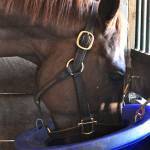Power of Smell: Scents May Pique Appetite in Horses

Can you remember the last time the smell of a favorite food instantly made you hungry? Like humans, horses respond to olfactory cues. Adding an enticing stimuli, anise oil in particular, may boost feed intake, according to recent research.*
Horses occasionally turn up their noses at feed, causing owners considerable frustration, especially if a horse visibly drops weight, loses its topline, or shows signs of gastric ulceration.
“Abrupt changes in feed or a small change in forage, concentrate, or supplement may make horses back away from their feed buckets and hay nets. Changes in their daily routine, exercise level, or management conditions, and even pain, injury, illness, or stress, can cause a horse to retreat from feed and hay,” said Catherine Whitehouse, M.S., a Kentucky Equine Research nutritionist.
“In some cases, horses can be tempted to eat by offering multiple small meals of fresh feed each day. I also recommend a digestive health supplement such as EquiShure to support appetite and gastrointestinal health in hard keepers or any horse with decreased voluntary intake,” suggested Whitehouse.
While hand-feeding may entice small dogs to eat, it clearly won’t work for horses. Olfactory stimulation may provide a more viable alternative.
“In some feed flavor studies, anise was a favorite of horses. Anise is a flowering plant native to the eastern Mediterranean region and southwest Asia. The flavor and aroma of its seeds resemble that of black licorice,” Whitehouse described.
To determine if horses were attracted to anise aroma, not just the flavor, and to see if their appetites could be piqued, false bottom pans were constructed. The feed pans had small openings that allowed the aroma of anise-soaked gauze to emanate from under the pans.
At mealtime, horses entered feeding stocks with a two-sided feeding bunk. The false-bottom anise pan was on one side of the bunk while a similar pan with corn oil was placed on the other. Horses were offered a small amount of crimped oats in the pans. Their behavior was then observed and recorded. Behaviors included positive ones, such as sniffing and consuming the feed, and aversive ones, like retracted lips, gaping mouth, and tongue protrusion. The meal was considered finished when more than 75% of the oats were consumed.
“Compared to the corn oil, horses sniffed anise more frequently before consuming oats. The horses ate the oats from the anise pan before the oats from the corn oil pan, and finished the anise ones first, too, showing a clear preference for anise aroma,” Whitehouse explained.
This study shows that olfactory stimulation may entice horses to eat and could be a way to encourage feed intake if feed additives are ineffective.
While this study was performed at Southern Illinois University, Kentucky Equine Research continues to do its own flavor preference trials. An early study was designed to determine which fruit flavors horses prefer (cherry claimed victory over apple, citrus, and teaberry), while a more recent study helped identify a new flavor for the proven marine-derived omega-3 supplement EO-3. Learn more about palatability testing in horses.
*Perry, E., and J. Fenton. 2021. An assessment of olfactory influence on equine feeding preferences. Journal of Equine Veterinary Sciences 100:103508.








